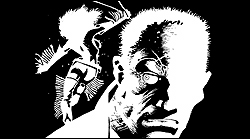Hookers with guns. There’s a kind of cinematic purity to it: sex and violence with no frills on the side. The clarity is black-and-white, like the rest of the comic-book world of Sin City (which opens Friday, April 1, at the Neptune and other theaters). In adapting three stories from Frank Miller’s graphic-novel series, Robert Rodriguez reduces his palette to almost only two tones, like the ones and zeroes of his all-digital production. Morality is no less stark, except the hookers are good—a buxom band of free agents defending the Old Town quarter of Basin City against all comers. And the villains tend to be powerful priests, police officers, and politicians who abuse their station. Everything’s reversed, like a film negative, and Rodriguez sometimes mimics that effect by rendering his characters in white silhouette against a black background.
For comic-book newbies accustomed to bright-and-shiny adaptations like Spider-Man, Sin City is an unfamiliar and pitiless place. It’s disorienting—leaping into three slightly overlapping segments without explanation—and, above all, dark. If you can’t laugh at the constant violence (there’s almost no sex), don’t bother going. There’s blood everywhere, but it’s almost never red, since Rodriguez knows that color would keep you from seeing anything else. Instead the stuff generally oozes white, black, and yellow. For those who demand strict fidelity to their comics, Sin City is a purist’s film, bold and audacious. It doesn’t let in outsiders willingly, and those who come had better be well armed.
When a woman-beating lout (Benicio Del Toro) goes prowling in Old Town with his gang, it’s like chumming for sharks. Private investigator Dwight (Clive Owen) thinks the hookers (led by Rosario Dawson) would appreciate some help from his guns, but he might as well bring a mop. (He concedes, “The ladies are the law here, beautiful and merciless.” The film is thick with such voice-overs, in lieu of thought bubbles.) Like two other men in Basin City, Dwight’s got a rescuer complex; more than one reference is made to Lancelot and Galahad. These guys truly are knights in dirty armor, to borrow a phrase from Raymond Chandler.
Sin Cityfirst appearedin 1991, not long after Miller helped revive the Batman franchise, which was then reintroduced on the big screen as a film noir. He’s credited with giving the caped crusader gravitas, guilt, flaws, and angst; the old TV camp factor was sent scurrying into all those shadows. Nobody wears a cape here, though vengeful thug Marv (Mickey Rourke) has borderline superpowers: leaping down stairwells, punching out scores of cops, pretty much impervious to bullets and electricity. Only one problem—he may be delusional, as he pops pills out of a glowing orange prescription bottle. It’s one of the little daubs of color Rodriguez occasionally deploys—like the girl in the red dress at the end of Schindler’s List—to anchor all that murk. Also in color are the golden hair of a murdered hooker Marv loved and the red, heart-shaped bed where they were last together.
Cars glint emerald and red, too; eyes flash blue and green; and in the film’s last, strangest episode, a character called Yellow Bastard (Nick Stahl, Gollumized in prosthetics) is quite literally yellow. Color doesn’t come cheap in comic books, and it’s used sparingly for that reason. For Miller and other artists, color is almost a narrative device—deciding how and when to use it shapes the story. For Rodriguez, sharing his director’s credit with Miller, he’s almost got the opposite problem: shooting digital, he can apply any color, or any character, wherever he likes. (All the performers worked in front of green screens.)
Most comic-book movies are said to “leap off the page” as a compliment. Sin City does the opposite: It burrows into the cheap paper and ink. It makes a virtue of flatness. When cop Hartigan (Bruce Willis) twice tries to rescue a girl called Nancy in a story separated by an eight-year interval, their relationship is sketched in a few simple strokes—a steam-wreathed pier, a prison cell, a hospital bed, a man walking through trees in the snow. He’s an archetype—a kinder way of saying a cliché—to whom his partner (Michael Madsen) can warn, “You’re pushing 60, and you got a bum ticker!”
Sure, it’s corny, but Miller’s world is made up of such stock expressions and characters. Minor hoodlums discuss cars in Shakespearean cadences. All the autos are vintage ’40s and ’50s models, but characters can also use cell phones. Sin City borrows left and right: from Arthurian legend, noir, Hong Kong action flicks, and even horror (in the case of Yellow Bastard). It’s both terribly dated and terribly up-to-date.
Willis and Owen are done up like traditional movie toughs, while Roarke wears enough prosthetics on his nose and chin to pass as an Easter Island statue. Del Toro, too, has had his face reconfigured to fit the cartoon context. Maleness is on steroids in Sin City, and women don’t really count for much except as things to be feared (e.g., the Old Town hookers) or to be rescued (Jessica Alba plays the grown Nancy). Crashing the all-boy party is Quentin Tarantino, who directs a black-comic scene between Owen and an unusually chatty Del Toro as they drive through the rain.
Visually, Sin City is wildly imaginative—but also wildly derivative, since Rodriguez set out to copy Miller’s drawings on film. To say he succeeds is a genuine compliment, yet therein lies the movie’s shortcoming: the men are all types; the women are all objects; and the shootings, beatings, swirlies, and decapitations matter more for their rendering than their meaning. A good movie needn’t have reference to the real world or real people, but it ought to adhere to the rules of its own internal aesthetic. Says Marv of his quest for vengeance, “I’ve been killing my way to the truth.” In Sin City, killing seems like the only truth there is.








